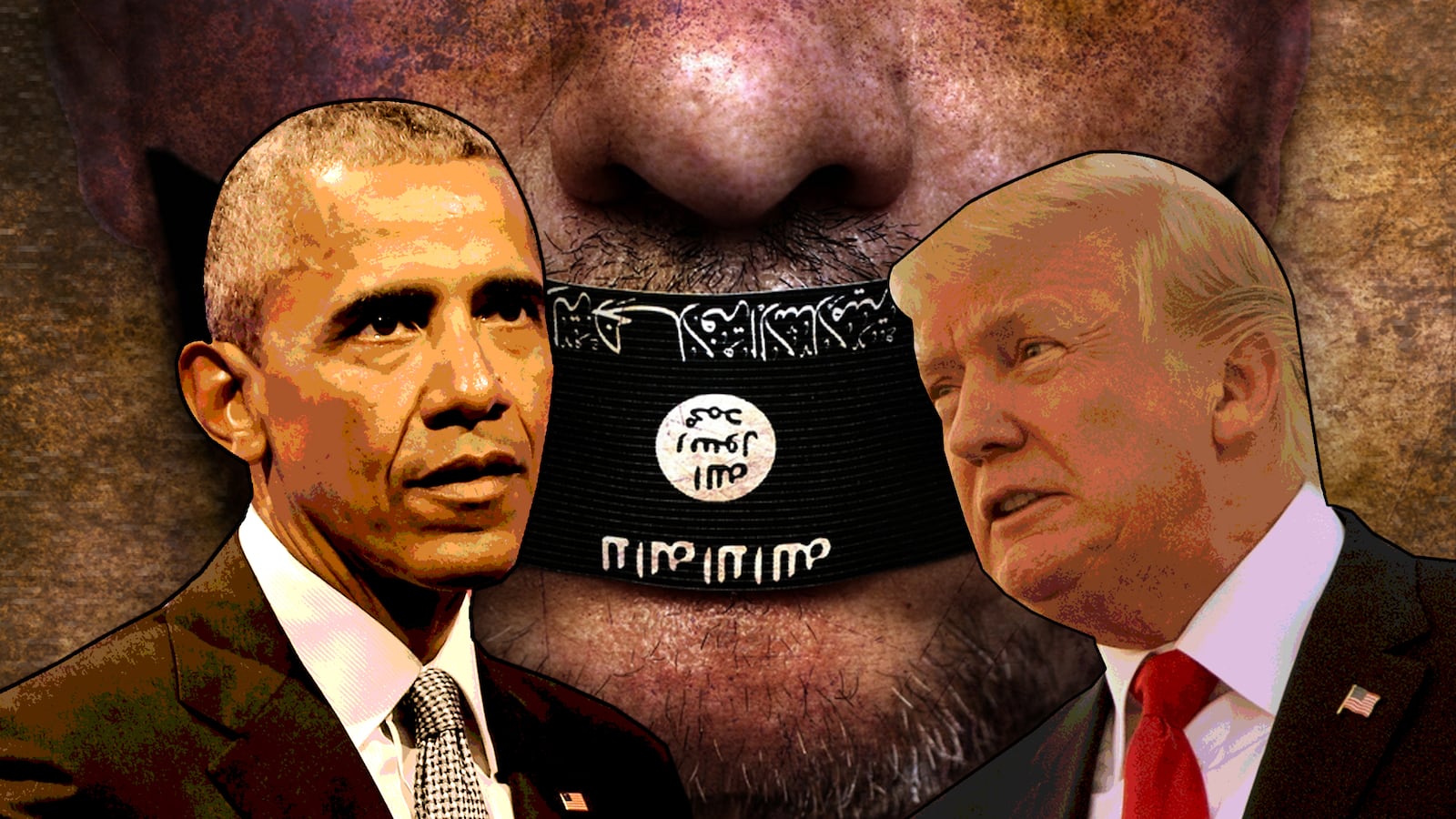U.S. special operations forces have removed roughly 50 top ISIS leaders off the battlefield since President Donald Trump took office, down from 80 killed in the last six months of the Obama administration, according to figures obtained by The Daily Beast.
“The pace and the way they have gone about going after these HVT’s [High-value targets] hasn’t changed,” said coalition spokesman Col. Ryan Dillon of the U.S. special operations’ campaign to take ISIS commanders off the Iraqi and Syrian battlefields.
Those closest to ISIS leader Abu Bakr al-Baghdadi have been hit hardest. “Most of them were killed in the last year of the Obama administration,” he said. “If there was a block chart of Baghdadi and all of his bubbas, we are hitting the fifth- and sixth-string leaders of the organization.”
Coalition air strikes have increased under Trump, rising from an average of roughly 440 a month in the last six months of 2016 to just under 800 a month now, as coalition forces have liberated most of Mosul in Iraq, and breached ISIS’ Syrian capital of Raqqa. But the lower numbers of high-value targets killed points to the deadly success of the strategy built by the Obama White House.
Trump’s changes to the campaign so far have been tactical—namely, giving the military more autonomy to strike, including special operators. But the effectiveness of the current Obama-era strategy of attacking ISIS via local forces together with allies calls into question whether there’s a need for more dramatic revision.
That’s presented a dilemma for those working on the Trump anti-ISIS strategy and slowed its public unveiling, U.S. officials tell The Daily Beast. The White House has asked defense officials to come up with new ideas to help brand the Trump campaign as different from its predecessor, according to two U.S. officials and one senior administration official. They spoke on condition of anonymity to discuss the sensitive debates.
The senior administration official described Trump’s plan as “relying even more” on special operations working together with local partner forces. “But that’s nuanced, like most of the suggested changes” and doesn’t easily translate to a talking point, he said. That could help explain why Trump has twice missed his own deadline for unveiling the new anti-ISIS strategy.
The White House and the Pentagon declined to comment.
The Obama administration’s anti-ISIS plan included nine lines of effort, including using diplomatic and economic pressure to reduce ISIS’ ability to sustain its rule and spread its ideology. The Obama White House had already stepped up the number of advisers on the ground in Iraq and Syria, and established a special operations task force in Iraq with major outposts in Syria to help guide local forces, as part of the larger coalition effort. Small teams of U.S. forces have embedded with local units and Turkish troops inside Syria, and with Iraqi and Kurdish troops in Iraq to help make them more effective.
Special operators have also launched multiple solo raids that have decimated ISIS’ leadership ranks.
“These figures underscore the fact that the Obama administration waged an aggressive war against ISIL [another name for ISIS], guided by a comprehensive strategy that put the group on the path to lasting defeat,” said former Obama official Ned Price in an email. “It is no surprise that the Trump administration has largely adopted our strategy despite hallmark bluster from President Trump about a purportedly more aggressive strategy we have yet to see.”
The main gripe from military and intelligence professionals about the last White House was that President Barack Obama delayed or deferred making tough decisions on Syria that meant territory was lost—or that forces friendly to the U.S. made other alliances when they couldn’t get weapons or other supplies rapidly enough from the Americans.
The other complaint was that the White House itself was involved in individual tactical decisions like whether to put U.S. special operations forces in harm’s way to strike a target, though Obama veterans have consistently pushed back against that complaint, saying some raids and other types of strikes can have strategic blowback.
Trump’s changes thus far have also been tactical rather than adjusting the overall campaign strategy. He’s dropped the alleged micromanagement of the Obama administration in favor of granting more authority to Pentagon chief Jim Mattis, who in turn gave it to his commanders in the field.
Trump “delegated authority to the right level to aggressively and in a timely manner move against enemy vulnerabilities,” Mattis told reporters in May, adding that Trump also “directed a tactical shift from shoving ISIS out of safe locations in an attrition fight to surrounding the enemy in their strongholds so we can annihilate ISIS,” and prevent foreign fighters from escaping.
Coalition spokesman Dillon said that’s meant U.S. advisers have had been able to react more autonomously on the battlefield, moving where their partner forces need them rather than calling to higher headquarters for permission.
“Previous authorities had placed some limits on the placement of U.S. advisors, as well as the availability of some of our fire support assets to provide sustained fires in our operations to defeat ISIS, particularly in Syria,” Dillon added, referring to the addition of Apache attack helicopters to pound ISIS defenses.
In other areas where ISIS and other militants hold sway, that expanded authority has meant more operations against al Qaeda of the Arabian Peninsula in Yemen, including the one wherein Navy SEAL Senior Chief Ryan Owens was lost to enemy gunfire.
Bombing against enemy targets in Afghanistan has increased, with more strikes in the first six months of the Trump administration than in all of 2016, including the “Mother of all bombs,” dropped on ISIS caves there. But U.S. military spokesman Capt. Bill Salvin in Kabul said that’s related to the “expanded authorities granted to General Mick Nicholson by President Obama in June of last year,” to support the Afghan National Army.
“From Jan. – Jun. 2016 we conducted just over 200 kinetic strikes total,” he emailed from Kabul. “From June 17 - Dec 31, we conducted more than 800 strikes.”
In Somalia, there has been one operation using Obama-era authorities in which a Navy SEAL was killed. The Pentagon has used the authorities extended under the Trump administration twice, on two strikes where no U.S personnel were at risk, the senior official said.
And while there’s a higher pace of strikes in Iraq and Syria, there are simply fewer ISIS fighters to hit, coalition spokesman Dillon said. He estimated there are about 5,000 ISIS fighters remaining in pockets throughout Iraq and up to 10,000 still in Syria. That’s down from a high of between 20,000 to 30,000 foreign fighters in Iraq and Syria at the start of the crisis, many of whom joined the fight after ISIS captured large parts of both countries in 2014.
“At the high water mark in early 2015, there was an estimated 1,500 into Iraq and Syria a month,” Dillon said. “Now there are less than a 100 foreign fighters entering a month.” So as U.S. forces and their allies take enemies off the battlefield, there’s a limited pool to replace them.
Recent announced kills include a May 11 strike that killed ISIS’ external operations planner Abu Asim al-Jazaeri and a May 31 strike that killed chief ISIS cleric Turki al-Binali, a confidante to ISIS leader al-Baghdadi. Both were killed in Mayadin, a town where many ISIS senior leaders escaped prior to U.S. allies encircling ISIS’ once-de facto capital of Raqqa. A June 16 strike took aim at ISIS’ attempts to manage its network elsewhere, killing Fawaz al-Rawi, a financier with networks through North Africa and the Mideast.
Many senior leaders have tried to flee to other countries, to start ISIS operations anew, or they’ve tried to melt back into the local populations for a long-term guerilla-style fight. That harder-to-win, less tangible fight, spanning multiple countries and continents, will be the real test for whatever Trump’s team eventually unveils.
For those in the trenches, the most refreshing change is that many no longer feel constrained when asking for more troops or resources if they feel they are necessary. Troop numbers were a constant source of conflict between the Pentagon and the Obama White House, which wanted to draw troops down to force Afghan forces to take the brunt of the fight, while U.S. commanders feared the local force wasn’t ready. So commanders worked around the Obama-ordered threshold of just under 8,500 troops by sending a brigade’s combat troops but leaving behind their supporting mechanics and hiring contractors at greater cost to do the same jobs.
“It’s more intellectually honest now,” one senior defense official said.
Correction: This story was corrected to reflect that the U.S. combat action that cost the life of a Navy SEAL in Somalia was carried out under Obama-era authorities.





